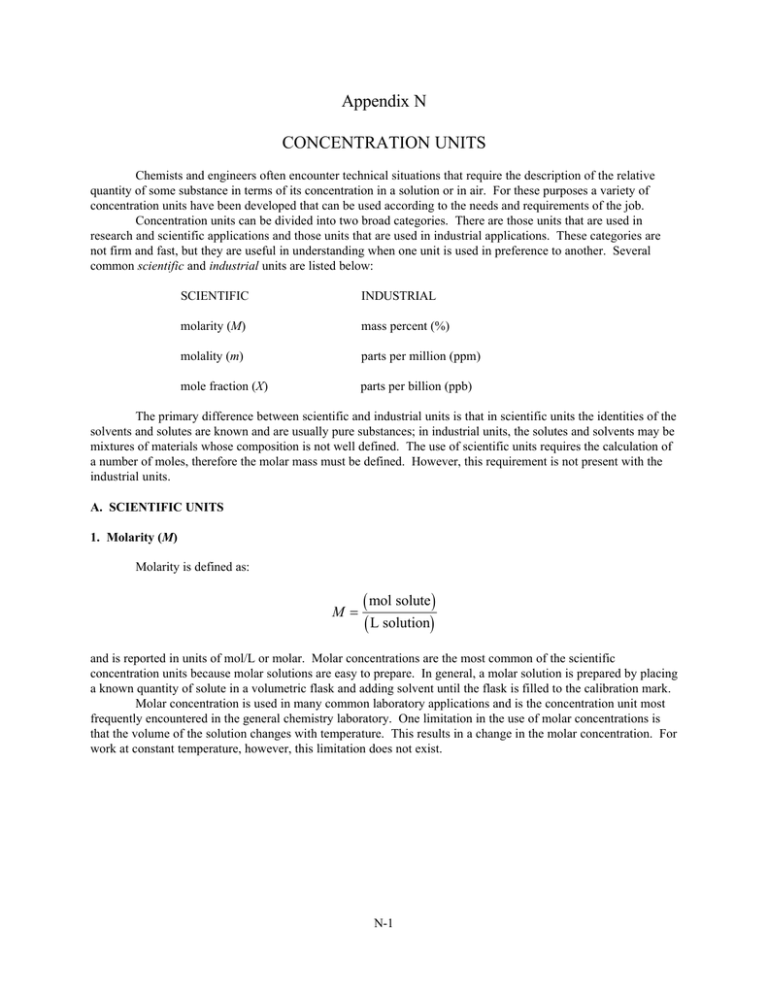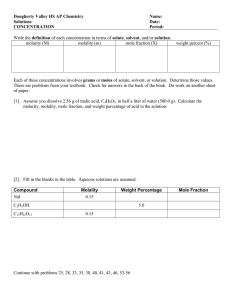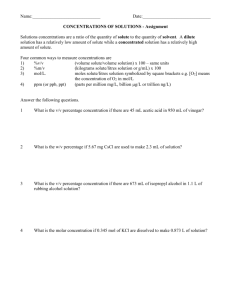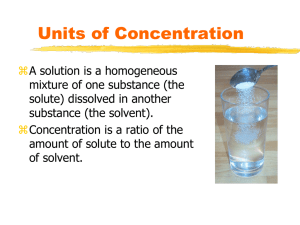Appendix N CONCENTRATION UNITS
advertisement

Appendix N CONCENTRATION UNITS Chemists and engineers often encounter technical situations that require the description of the relative quantity of some substance in terms of its concentration in a solution or in air. For these purposes a variety of concentration units have been developed that can be used according to the needs and requirements of the job. Concentration units can be divided into two broad categories. There are those units that are used in research and scientific applications and those units that are used in industrial applications. These categories are not firm and fast, but they are useful in understanding when one unit is used in preference to another. Several common scientific and industrial units are listed below: SCIENTIFIC INDUSTRIAL molarity (M) mass percent (%) molality (m) parts per million (ppm) mole fraction (X) parts per billion (ppb) The primary difference between scientific and industrial units is that in scientific units the identities of the solvents and solutes are known and are usually pure substances; in industrial units, the solutes and solvents may be mixtures of materials whose composition is not well defined. The use of scientific units requires the calculation of a number of moles, therefore the molar mass must be defined. However, this requirement is not present with the industrial units. A. SCIENTIFIC UNITS 1. Molarity (M) Molarity is defined as: M= ( mol solute) ( L solution) and is reported in units of mol/L or molar. Molar concentrations are the most common of the scientific concentration units because molar solutions are easy to prepare. In general, a molar solution is prepared by placing a known quantity of solute in a volumetric flask and adding solvent until the flask is filled to the calibration mark. Molar concentration is used in many common laboratory applications and is the concentration unit most frequently encountered in the general chemistry laboratory. One limitation in the use of molar concentrations is that the volume of the solution changes with temperature. This results in a change in the molar concentration. For work at constant temperature, however, this limitation does not exist. N-1 2. Molality (m) Molality is defined as: m= ( mol solute) ( kg solvent ) and is reported in units of mol/1000 g, mol/kg, or molal. Molal concentration is less convenient to use than molarity because the mass of the solvent must be determined rather than its volume. In practice, generally only small quantities of these solutions are prepared and therefore this inconvenience is minor. Molal concentrations are used in experiments determining freezing point depressions, boiling point elevations, and in other cases where the temperature of the solution changes over the course of the experiment. Molal concentrations eliminate the problem of the dependence of volume on temperature seen with molar solutions because masses are not temperature dependent. 3. Mole Fraction (X) Mole fraction is defined as: X = ( mol solute) ( mol solute + mol solvent ) As with molality, preparing solutions using mole fraction units requires the weighing of solute and solvent so that the number of moles can be calculated. For many solutions, the quantity of solute is small compared to that of solvent, so the numerical values of mole fraction are frequently very small numbers. Because moles are the units of both numerator and denominator, mole fraction is a unit-less quantity. B. Industrial Units 1. Mass Percent (%) (or percent mass) Mass % is defined as: ( mass of solute) × 100 %= ( total mass of solution) A similar relationship holds for volume percent (or percent by volume). ( volume of solute) × 100 % volume = ( total volume of solution) Mass percent is used to express the concentration of substances that are not pure, for example, the content of butterfat in milk. Butterfat is not a pure substance, but its mass percent in milk determines the legal difference between skim milk, whole milk, and table cream. Mass percent is also used in the metallurgical industry to describe the quantities of different components in alloys. Certain generic names such as "stainless steel" imply the presence of certain minimum levels of different components in the steel. In this case, the definitions are not legal ones, but are standard compositions accepted by N-2 industry. Examples are: COMMON NAME MASS-PERCENT ELEMENTAL COMPOSITION brass dental amalgam 18-carat gold stainless steel 67-90% Cu, 10-33% Zn 50% Hg, 35% Ag, 15% Sn 75% Au, 10-20% Ag, 5-15% Cu 73-79% Fe, 14-18% Cr, 7-9% Ni 2. Parts per Million Parts per million (ppm) is defined as: ( mass of solute) 6 ppm = × 10 total mass of solution The unit “parts per million” is usually used for very dilute aqueous solutions. For very dilute aqueous solutions the density of the solution is assumed to be the same as the density of pure water (1.00 g/mL), so that one liter of solution has a mass of 1000 g and 1000 L of solution has a mass of 106 g. This information gives two additional definitions of parts per million. ppm = ( g solute) (1000 L solution) ppm = ( mg solute) ( L solution) Parts per million is used to describe concentrations in solutions containing poorly defined or unidentified solutes or mixtures of solutes. Parts per million is also used to describe concentration levels to those who are unfamiliar with the concept of moles. Tap water contains a variety of dissolved impurities, mostly minerals. A simple way of describing the levels of these impurities, often called dissolved solids, is to measure out a sample, 10 mL for example, into a weighed aluminum cup and evaporate the water. The mass of the remaining solids is determined by difference. Dividing the mass in mg of remaining solids by 0.010 L gives the concentration of the dissolved solids in ppm. Notice that the identity of the solids is not specified, but a measure of their concentration is known. The Navy uses the level of chloride ions in boiler water as an early warning indicator for seawater leaks into condensers. The titration test that is used precipitates the chloride ions as a mercury compound. The chloride ions themselves are present in water along with many cations including sodium, potassium, magnesium, and calcium ions. Because it is not appropriate to talk about the amount of sodium chloride in the boiler water, the results from the mercury titration are used to determine the mass in mg of chloride ions in the sample and are in turn expressed as ppm of chloride. N-3 3. Parts per Billion Parts per billions is defined as: ( mass of solute) × 109 ppb = ( total mass of solution) For very dilute aqueous solutions the approximation is: ppb = ( µg solute) ( L solution) Parts per billion is used for reporting trace contaminants of substances in water supplies and for substances present in extremely small quantities in other systems. N-4







